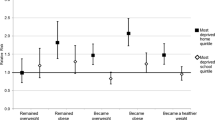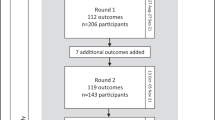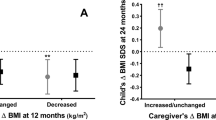Abstract
Background
Attending government-regulated centre-based childcare may influence important health behaviours including dietary quality, physical activity and routines related to child growth. However, the relationship between centre-based childcare and childhood obesity remains unclear.
Objectives
The primary objective was to evaluate the association between centre-based childcare attendance in early childhood and body mass index z-score (zBMI) in later childhood. Secondary objectives included exploring whether family income, child sex, or non-centre-based setting modified these relationships.
Methods
A prospective cohort study of children aged 1 to 10 years who participated in the TARGet Kids! cohort was conducted. Linear mixed-effect modelling was used to evaluate the relationship between centre-based childcare attendance (in hours/week) compared to non-centre-based childcare between 1–4 years of age and zBMI between 4 and 10 years of age. Generalised estimating equation modelling was used to explore weight status categories. Models were adjusted for confounders and effect modification was explored.
Results
A total of 3503 children were included. Children who attended centre-based childcare full-time (40 h/week) had 0.11 (95% CI: −0.19, −0.03; p = 0.01) lower zBMI at 4 and 7 years of age and lower odds of overweight and obesity at 4 years (OR 0.78; 95% CI: 0.62, 0.97; p = 0.03), but no evidence of an association was found at 10 years of age. Children from families with income < $50,000CDN who attended centre-based childcare full-time had 0.32 (95% CI: −0.50, −0.14; p = 0.001) lower zBMI and lower odds of overweight and obesity (OR 0.52; 95% CI: 0.28, 0.99; p = 0.05) at 10 years of age.
Conclusions
Attending centre-based childcare in early childhood was associated with a lower zBMI and odds of overweight and obesity in later childhood. These associations were stronger for children from lower income families. Centre-based childcare may be an early intervention for the prevention of childhood obesity.
Clinical trial
Clinical Trial Registry Number: NCT01869530 (clinicaltrials.gov).
This is a preview of subscription content, access via your institution
Access options
Subscribe to this journal
Receive 12 print issues and online access
$259.00 per year
only $21.58 per issue
Buy this article
- Purchase on Springer Link
- Instant access to full article PDF
Prices may be subject to local taxes which are calculated during checkout



Similar content being viewed by others
Data availability
The datasets generated during and/or analysed during the current study are not publicly available as we do not have REB approval for data sharing.
References
Abarca-Gómez L, Abdeen ZA, Hamid ZA, Abu-Rmeileh NM, Acosta-Cazares B, Acuin C, et al. Worldwide trends in body-mass index, underweight, overweight, and obesity from 1975 to 2016: a pooled analysis of 2416 population-based measurement studies in 128.9 million children, adolescents, and adults. Lancet. 2017;390:2627–42.
Rao DP, Kropac E, Do MT, Roberts KC, Jayaraman GC. Childhood overweight and obesity trends in Canada. Health Promot Chronic Dis Prev Can. 2016;36:194–8.
Sahoo K, Sahoo B, Choudhury AK, Sofi NY, Kumar R, Bhadoria AS. Childhood obesity: causes and consequences. J Family Med Prim Care. 2015;4:187–92.
Rankin J, Matthews L, Cobley S, Han A, Sanders R, Wiltshire HD, et al. Psychological consequences of childhood obesity: psychiatric comorbidity and prevention. Adolesc Health Med Ther. 2016;7:125–46.
Singh AS, Mulder C, Twisk JW, van Mechelen W, Chinapaw MJ. Tracking of childhood overweight into adulthood: a systematic review of the literature. Obes Rev. 2008;9:474–88.
Juonala M, Magnussen CG, Berenson GS, Venn A, Burns TL, Sabin MA, et al. Childhood adiposity, adult adiposity, and cardiovascular risk factors. N Engl J Med. 2011;365:1876–85.
Statistics Canada. The rise of the dual-earner family with children. Ottawa, Canada. Catalogue no. 11-630-X. 2016. Available from: https://www150.statcan.gc.ca/n1/pub/11-630-x/11-630-x2016005-eng.htm.
Statistics Canada. Child care arrangements for children aged 0 to 5 years, 2020. Ottawa, Canada. Catalogue no. 11-001-X. 2021. Available from: https://www150.statcan.gc.ca/n1/pub/11-627-m/11-627-m2021039-eng.htm.
Cui J, Natzke L. Early Childhood Program Participation: 2019 (NCES 2020-075REV), National Center for Education Statistics, Institute of Education Sciences, U.S. Department of Education. Washington, DC. 2021. Available from: http://nces.ed.gov/pubsearch/pubsinfo.asp?pubid=2020075REV.
Child Care and Early Years Act. Canada: Government of Ontario; 2014. p. S.O. 2014, c.11, Sched.1. Available from: https://www.ontario.ca/laws/statute/14c11.
Varmuza P, Perlman M, White LA. Understanding early childhood education and care utilization in Canada: implications for demand and oversight. Int J Child Care Educ Policy. 2019;13:7.
Bassok D, Fitzpatrick M, Greenberg E, Loeb S. Within- and between-sector quality differences in early childhood education and care. Child Dev. 2016;87:1627–45.
Varmuza P, Perlman M, White LA. Ontario as a case study for modernizing Home Child Care licensing and support. Can Public Admin. 2021;64:485–505.
Ward S, Bélanger M, Donovan D, Carrier N. Systematic review of the relationship between childcare educators’ practices and preschoolers’ physical activity and eating behaviours. Obes Rev. 2015;16:1055–70.
National Academies of Sciences, Engineering, and Medicine. Obesity in the Early Childhood Years: State of the Science and Implementation of Promising Solutions: Workshop Summary. Washington, DC: The National Academies Press. 2016. https://doi.org/10.17226/23445.
Kaphingst KM, Story M. Child care as an untapped setting for obesity prevention: state child care licensing regulations related to nutrition, physical activity, and media use for preschool-aged children in the United States. Prev Chronic Dis. 2009;6:A11.
Wood AC, Blissett JM, Brunstrom JM, Carnell S, Faith MS, Fisher JO, et al. Caregiver influences on eating behaviors in young children: a scientific statement From the American Heart Association. J Am Heart Assoc. 2020;9:e014520.
Skinner JD, Carruth BR, Bounds W, Ziegler P, Reidy K. Do food-related experiences in the first 2 years of life predict dietary variety in school-aged children? J Nutr Educ Behav. 2002;34:310–5.
Lioret S, Campbell KJ, McNaughton SA, Cameron AJ, Salmon J, Abbott G, et al. Lifestyle patterns begin in early childhood, persist and are socioeconomically patterned, confirming the importance of early life interventions. Nutrients. 2020;12:724.
Wyszyńska J, Ring-Dimitriou S, Thivel D, Weghuber D, Hadjipanayis A, Grossman Z, et al. Physical activity in the prevention of childhood obesity: the position of the European Childhood Obesity Group and the European Academy of Pediatrics. Front Pediatr. 2020;8:535705.
Leroy JL, Gadsden P, Guijarro M. The impact of daycare programmes on child health, nutrition and development in developing countries: a systematic review. J Dev Eff. 2012;4:472–96.
Black L, Matvienko-Sikar K, Kearney PM. The association between childcare arrangements and risk of overweight and obesity in childhood: a systematic review. Obes Rev. 2017;18:1170–90.
Alberdi G, McNamara AE, Lindsay KL, Scully HA, Horan MH, Gibney ER, et al. The association between childcare and risk of childhood overweight and obesity in children aged 5 years and under: a systematic review. Eur J Pediatr. 2016;175:1277–94.
Carsley S, Borkhoff CM, Maguire JL, Birken CS, Khovratovich M, McCrindle B, et al. Cohort profile: the applied research group for kids (TARGet Kids!). Int J Epidemiol. 2015;44:776–88.
Statistics Canada. Canadian Community Health Survey—annual component (CCHS). Ottawa: Canada. 2013. Available from: https://www23.statcan.gc.ca/imdb/p2SV.pl?Function=getSurvey&Id=144170.
Secker D. Promoting optimal monitoring of child growth in Canada: using the new WHO growth charts. Can J Diet Pract Res. 2010;71:e1–3.
Centers for Disease Control and Prevention. Third National Health and Nutrition Examination (NHANES III). [Video]. Pittsburgh, PA: Centers for Disease Control and Prevention and National Center for Health Statistics; 2003. Available from: https://wwwn.cdc.gov/nchs/nhanes/nhanes3/anthropometricvideos.aspx.
de Onis M, Onyango AW, Borghi E, Siyam A, Nishida C, Siekmann J. Development of a WHO growth reference for school-aged children and adolescents. Bull World Health Organ. 2007;85:660–7.
de Onis M, Lobstein T. Defining obesity risk status in the general childhood population: which cut-offs should we use? Int J Pediatr Obes. 2010;5:458–60.
Statistics Canada. Low income cut-offs (LICOs) before and after tax by community size and family size, in current dollars. Table 11-10-0241-01 from 2016–2020. 2022. https://doi.org/10.25318/1110024101-eng. Available from: https://www150.statcan.gc.ca/t1/tbl1/en/tv.action?pid=1110024101.
Government of Ontario. Early Years and Child Care Annual Report 2019. Ministry of Education. 2021. Available from: https://files.ontario.ca/edu-early-years-and-child-care-annual-report-2019-en-2021-03-19.pdf.
Government of Ontario. Ontario’s Early Years and Child Care Annual Report 2022. Ministry of Education. 2023. Available from: https://www.ontario.ca/page/ontarios-early-years-and-child-care-annual-report-2022.
Vanderhout SM, Keown-Stoneman CDG, Birken CS, O’Connor DL, Thorpe KE, Maguire JL. Cow’s milk fat and child adiposity: a prospective cohort study. Int J Obes. 2021;45:2623–8.
Eny KM, Chen S, Anderson LN, Chen Y, Lebovic G, Pullenayegum E, et al. Breastfeeding duration, maternal body mass index, and birth weight are associated with differences in body mass index growth trajectories in early childhood. Am J Clin Nutr. 2018;107:584–92.
Harrell F. Regression modeling strategies with applications to linear models, logistic and ordinal regression, and survival analysis. New York: Springer; 2015.
van Buuren S, Groothuis-Oudshoorn K. mice: multivariate imputation by chained equations in R. Journal of Statistical Software. 2011;45:1–67.
Fitzmaurice GM, Laird NM, Ware JH. Applied longitudinal analysis (2nd ed.). Wiley. 2011. https://doi.org/10.1002/9781119513469.
R Core Team. R: a language and environment for statistical computing. R Foundation for statistical computing. Vienna, Austria; 2013.
O'Connor EA, Evans CV, Burda BU, Walsh ES, Eder M, Lozano P. Screening for Obesity and Intervention for Weight Management in Children and Adolescents: Evidence Report and Systematic Review for the US Preventive Services Task Force. JAMA. 2017;317:2427–2444.
Kolsgaard MLP, Joner G, Brunborg C, Anderssen SA, Tonstad S, Andersen LF. Reduction in BMI z-score and improvement in cardiometabolic risk factors in obese children and adolescents. The Oslo Adiposity Intervention Study—a hospital/public health nurse combined treatment. BMC Pediatr. 2011;11:47.
Brown T, Moore TH, Hooper L, Gao Y, Zayegh A, Ijaz S, et al. Interventions for preventing obesity in children. Cochrane Database Syst Rev. 2019;7:Cd001871.
Lee R, Zhai F, Han W-J, Brooks-Gunn J, Waldfogel J. Head start and children’s nutrition, weight, and health care receipt. Early Child Res Q. 2013;28(4): https://doi.org/10.1016/j.ecresq.2013.06.003.
Bronfenbrenner U. Ecological systems theory. In: Six theories of child development: Revised formulations and current issues., Jessica Kingsley Publishers: London, England, 1992; p. 187–249.
Arlinghaus KR, Johnston CA. The importance of creating habits and routine. Los Angeles, CA: SAGE Publications; 2019; 142–4.
Shloim N, Edelson LR, Martin N, Hetherington MM. Parenting styles, feeding styles, feeding practices, and weight status in 4–12 year-old children: a systematic review of the literature. Front Psychol. 2015;6:1849.
Marr C, Reale S, Breeze P, Caton SJ. Grandparental dietary provision, feeding practices and feeding styles when caring for preschool-aged grandchildren: a systematic mixed methods review. Obes Rev. 2021;22:e13157.
Tandon PS, Zhou C, Lozano P, Christakis DA. Preschoolers’ total daily screen time at home and by type of child care. J Pediatr. 2011;158:297–300.
Anderson SE, Sacker A, Whitaker RC, Kelly Y. Self-regulation and household routines at age three and obesity at age eleven: longitudinal analysis of the UK Millennium Cohort Study. Int J Obes. 2017;41:1459–66.
Spagnola M, Fiese BH. Family routines and rituals: a context for development in the lives of young children. Infants Young Child. 2007;20:284–99.
Anderson SE, Whitaker RC. Household routines and obesity in US preschool-aged children. Pediatrics. 2010;125:420–8.
Spencer N, Raman S, O’Hare B, Tamburlini G. Addressing inequities in child health and development: towards social justice. BMJ Paediatr Open. 2019;3:e000503–e.
Gupta RP-S, de Wit ML, McKeown D. The impact of poverty on the current and future health status of children. Paediatr Child Health. 2007;12:667–72.
Ke J, Ford-Jones EL. Food insecurity and hunger: a review of the effects on children’s health and behaviour. Paediatr Child Health. 2015;20:89–91.
D’Souza NJ, Kuswara K, Zheng M, Leech R, Downing KL, Lioret S, et al. A systematic review of lifestyle patterns and their association with adiposity in children aged 5–12 years. Obes Rev. 2020;21:e13029.
Fuller A, Maguire JL, Carsley S, Chen Y, Lebovic G, Omand J, et al. Difficulty buying food, BMI, and eating habits in young children. Can J Public Health. 2018;108:e497–e502.
Geoffroy MC, Power C, Touchette E, Dubois L, Boivin M, Séguin JR, et al. Childcare and overweight or obesity over 10 years of follow-up. J Pediatr. 2013;162:753–8.e1.
Findlay L. Early learning and child care for children aged 0 to 5 years: a provincial/territorial portrait. Health Analysis Division, Analytical Studies Branch, Statistics Canada. Economic Insights. 11-626-X - 2019013 - No. 099. 2019. Available from: https://www150.statcan.gc.ca/n1/pub/11-626-x/11-626-x2019013-eng.pdf.
Dietz WH, Story MT, Leviton LC. Issues and implications of screening, surveillance, and reporting of children’s BMI. Pediatrics. 2009;124:S98–101.
Martin-Calvo N, Moreno-Galarraga L, Martinez-Gonzalez MA. Association between body mass index, waist-to-height ratio and adiposity in children: a systematic review and meta-analysis. Nutrients. 2016;8:512.
Kakinami L, Henderson M, Chiolero A, Cole TJ, Paradis G. Identifying the best body mass index metric to assess adiposity change in children. Arch Dis Child. 2014;99:1020–4.
Acknowledgements
We thank all of the participating families for their time and involvement in TARGet Kids! and are grateful to all practitioners who are currently involved in the TARGet Kids! practice-based research network.
Funding
Funding was provided by the Canadian Institutes of Health Research (CIHR) Institute of Human Development, Child, and Youth Health (MOP-333560 [to JM]). The funding agency had no role in study design; in the collection, analysis, and interpretation of data; in the writing of the report; and in the decision to submit the article for publication.
Author information
Authors and Affiliations
Consortia
Contributions
MK and JM conceptualised and designed the research study, performed the initial statistical analyses, interpreted the data, drafted the initial manuscript, and reviewed and revised the manuscript. CKS designed the study, supervised the statistical analyses and interpretation of data, and critically reviewed the manuscript for important intellectual content. CB and MP designed the study and critically reviewed the manuscript for important intellectual content. All authors read and approved the final manuscript as submitted and agree to be accountable for all aspects of the work.
Corresponding author
Ethics declarations
Competing interests
JLM has received research funding from the Canadian Institutes of Health Research, Physician Services Inc, Ontario SPOR Support Unit, as well as an unrestricted research grant for a completed investigator-initiated study from the Dairy Farmers of Canada (2011–2012) and Ddrops provided nonfinancial support (vitamin D supplements) for an investigator-initiated study on vitamin D and respiratory tract infections (2011–2015). C.B. has received research funding from the Canadian Institutes of Health Research, Heart and Stroke Foundation of Canada, Physician Services Inc, The Leong Center at the University of Toronto, Centre for Addictions and Mental Health, Ontario Child Health Support Unit (OCHSU) Impact Child Health Award, and a Walmart Community Grant through the SickKids Foundation for a study on food insecurity in the inpatient hospital setting. The other authors had no conflicts of interest relevant to this article to disclose.
Additional information
Publisher’s note Springer Nature remains neutral with regard to jurisdictional claims in published maps and institutional affiliations.
Supplementary information
Rights and permissions
Springer Nature or its licensor (e.g. a society or other partner) holds exclusive rights to this article under a publishing agreement with the author(s) or other rightsholder(s); author self-archiving of the accepted manuscript version of this article is solely governed by the terms of such publishing agreement and applicable law.
About this article
Cite this article
Kucab, M.D., Keown-Stoneman, C.D.G., Birken, C.S. et al. Centre-based childcare in early childhood and growth in later childhood: a prospective cohort study. Int J Obes 47, 724–731 (2023). https://doi.org/10.1038/s41366-023-01316-2
Received:
Revised:
Accepted:
Published:
Issue Date:
DOI: https://doi.org/10.1038/s41366-023-01316-2



